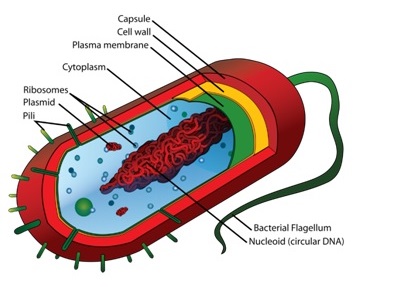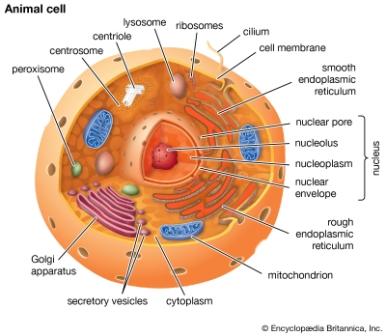Table of Contents
What is Cell?
The Cell is the basic unit of life on earth. A cell is defined as the basic structural and functional unit of life. A cell can independently perform all necessary activities to sustain life. Hence cell is the basic unit of life.

Who discovered Cell?

The Cell was discovered by Robert Hooke in 1665. The discovery of the cell would not have been possible if not for advancements in the microscope. Interested in learning–more about the microscopic world, scientist Robert Hooke improved the design of the existing compound microscope in 1665. His microscope used three lenses and a stage light, which illuminated and enlarged the specimens. He placed a piece of cork under the microscope. To him, the cork looked as if it was made of tiny pores, which he came to call “cells” because they reminded him of the cells in a monastery.
After Hooke’s discovery, bacteria and protozoa was discovered by Dutch scientist Antonie van Leeuwenhoek. It was unsurprising that van Leeuwenhoek would make such a discovery. He was a master microscope maker and perfected the design of the simple microscope.Antonie van Leeuwenhoek classified cell into two type-
1. Unicellular.
2. Multicellular.
What is Cell theory and who formulated it?
Cell theory is a scientific theory first formulated in the mid-nineteenth century, that living organisms are made up of cells, that they are the basic structural/organizational unit of all organisms, and that all cells come from pre-existing cells. Cells are the basic unit of structure in all organisms and also the basic unit of reproduction.
The three tenets of the cell theory are as described below:
1. All living organisms are composed of one or more cells.
2. The cell is the basic unit of structure and organization in organisms.
3. Cells arise from pre-existing cells.
While Rudolf Virchow contributed to the theory, he is not as credited for his attributions toward it. The two scientists: Theodor Schwann and Matthias Jakob Schleidenwere are given credit for developing cell theory. In 1839, Schleiden suggested that every structural part of a plant was made up of cells or the result of cells. He also suggested that cells were made by a crystallization process either within other cells or from the outside.
What cell membrane is?

The cell membrane (also known as the plasma membrane (PM) or cytoplasmic membrane), To ensure each cell remains separate from its neighbor, it is enveloped in a special membrane known as the plasma membrane. This membrane is predominantly made of phospholipids, which prevent water-based substances from entering the cell. The plasma membrane contains a range of receptors, which carry out a number of tasks, The cell membrane consists of a lipid bilayer, made up of two layers of phospholipids with cholesterols (a lipid component) interspersed between them, maintaining appropriate membrane fluidity at various temperatures. The membrane also contains membrane proteins, including integral proteins that span the membrane and serve as membrane transporters, and peripheral proteins that loosely attach to the outer (peripheral) side of the cell membrane, acting as enzymes to facilitate interaction with the cell’s environment.
Why cell division is important?
Cell division is important as our body is constantly replacing cells. Cells need to divide for a number of reasons, including the growth of an organism and to fill gaps left by dead and destroyed cells after an injury, for instance.
There are two types of cell division: Mitosis and meiosis.
Mitosis or M phase
In animals, the division of mitotic cells is only seen in the diploid somatic cells, while mitotic divisions in both haploid and diploid cells can be seen in plants. It is also called an equational division, as the number of parent and progeny cell chromosomes is identical. Mitosis is a process wherein a parent cell divides to form two identical daughter cells. Mitosis is called equational division because the two daughter cells have the same number of chromosomes as those present in the parent cell.
Meiosis
Meiosis creates sex cells, such as the male sperm and female egg cells. In meiosis, a small portion of each chromosome breaks off and sticks to another chromosome; this is called genetic recombination. This means that each of the new cells has a unique set of genetic information. It is this process that allows genetic diversity to occur. Meiosis is a double division in which a diploid cell forms four haploid cells, each having half the number of chromosomes. It consists of two divisions: meiosis I and meiosis II.
Meiosis I is called reductional division because the chromosome number is reduced to have in this process.
Meiosis II is called equational division because during this division the number of chromosomes remains the same as produced at the end of meiosis II
What is the size of the cell?
The size of cells in living organisms may be as small as a millionth of a meter (micrometer or micron) or maybe as large as a few centimeters. However, most of the cells are microscopic in size and are not visible to the unaided eye. They need to be enlarged or magnified by a microscope. The smallest cell is 0.1 to 0.5 micrometer in bacteria. The largest cell measuring 170 mm ×130 mm, is the egg of an ostrich. The size of the cells has no relation to the size of the body of the animal or plant. It is not necessary that the cells in the elephant be much bigger than those in a rat. The size of the cell is related to its function. For example, nerve cells, both in the elephant and rat, are long and branched. They perform the same function, that of transferring messages.
What are cell structure and functions?
The digestive organs together constitute the digestive system. Each organ in the system performs different functions such as digestion, assimilation, and absorption. Similarly, different organs of a plant perform specific/specialized functions. For example, roots help in the absorption of water and minerals. Leaves, as you have learned in Class VII, are responsible for the synthesis of food. Each organ is further made up of smaller parts called tissues. A tissue is a group of similar cells performing a specific function. Paheli realized that an organ is made up of tissues which in turn, are made up of cells. The cell is a living organism and is the basic structural unit.
What does Cytoplasm mean?

Cytoplasm means It is the jelly-like substance present between the cell membrane and the nucleus. Various other components, or organelles, of cells are present in the cytoplasm. These are mitochondria, Golgi bodies, ribosomes, etc.
A Nucleus in Cell-
A Nucleus in a cell is an important component of the living cell. It is generally spherical and located in the center of the cell. A nucleus can be stained and seen easily with the help of a microscope. The nucleus is separated from the cytoplasm by a membrane called the nuclear membrane. This membrane is also porous and allows the movement of materials between the cytoplasm and the inside of the nucleus. The cell nucleus contains all of the cell’s genome, except for the small amount of mitochondrial DNA and, in plant cells, plastid DNA. Nuclear DNA is organized as multiple long linear molecules in a complex with a large variety of proteins, such as histones, to form chromosomes. The genes within these chromosomes are structured in such a way to promote cell function. The nucleus maintains the integrity of genes and controls the activities of the cell by regulating gene expression—the nucleus is, therefore, the control center of the cell.
How does the nucleus structure-The nucleus contain nearly all of the cell’s DNA, surrounded by a network of fibrous intermediate filaments and enveloped in a double membrane called the “nuclear envelope”. The nuclear envelope separates the fluid inside the nucleus, called the nucleoplasm, from the rest of the cell. The size of the nucleus depends on the size of the cell it is contained in, with a nucleus typically occupying about 8% of the total cell volume. The nucleus is the largest organelle in animal cells. In mammalian cells, the average diameter of the nucleus is approximately 6 micrometers.
Difference between Prokaryotic and Eukaryotic Cell-
Every organism, be it micro-organism or macro-organism, is made up of cells. Prokaryotic cells are single-celled micro-organisms having a cell membrane. On the other hand, eukaryotic cells are organisms that have a nucleus.
Prokaryotic Cell-

Prokaryotes are single-celled organisms that are the earliest and most primitive forms of life on earth. As organized in the Three Domain System, prokaryotes include bacteria and archaeans. Some prokaryotes, such as cyanobacteria, are photosynthetic organisms and are capable of photosynthesis. Many prokaryotes are extremophiles and can live and thrive in various types of extreme environments including hydrothermal vents, hot springs, swamps, wetlands, and the guts of humans and animals. Prokaryotic bacteria can be found almost anywhere and are part of the human microbiota. They live on your skin, in your body, and on everyday objects in your environment. Prokaryotic organisms have varying cell shapes. The most common bacteria shapes are spherical, rod-shaped, and spiral.
Prokaryotic cells lack organelles found in eukaryotic cells such as mitochondria, endoplasmic reticulum, and Golgi complexes. According to the Endosymbiotic Theory, eukaryotic organelles are thought to have evolved from prokaryotic cells living in endosymbiotic relationships with one another.
Eukaryotic Cell-

Eukaryotic cells (from the Greek word Eukaryota, the union of EU – “true” and karyon “nut, nucleus”) are called all cells in whose cytoplasm a precisely defined nucleus can be found that contains most of their genetic material (DNA ). In this, they differ from prokaryotic cells, which are much more primitive and whose genetic material is distributed in the cytoplasm.
The eukaryotic cells are too complex than prokaryotic cells and evolved from them about 1.5 billion years ago. The appearance of eukaryotic cells marked an important step in the evolution of life as it laid the foundation for much greater biodiversity, including the emergence of certain cells within multicellular organizations, creating higher kingdoms: protists, fungi, plants, and animals. The living things formed by eukaryotic cells are called eukaryotes.
Size of Eukaryotic cell-
Eukaryotic cell size varies greatly from 10 mm to 500 mm. The Ostrich egg is the largest eukaryotic cell known measuring 170 mm X150 mm. In plants, the longest cells are the sclerenchyma fibers of Ramie (Boehmeria nivea) of Urticaceae. But in animals, neurons are the longest cells reaching up to 3 mt. in elephants and whales.
Eukaryotic cell types
There are different types of eukaryotic cells, but mainly, four are recognized, each with different structures and processes:
- Animal cells don’t have chloroplasts (because they don’t photosynthesize) or a cell wall. In contrast to plant cells, however, they have centrioles (organelles that are involved in cell division) and smaller, albeit more frequent, vacuoles. Due to the lack of a cell wall, animal cells can take on a large number of variable shapes and even devour other cells.
- Plant cells. They have a cell wall (made up of cellulose and proteins) that covers their plasma membrane, giving them rigidity, protection, and durability. Also, plant cells have chloroplasts, organelles that contain the chlorophyll needed to carry out the photosynthetic process. Another feature of this cell type is the presence of a large central vacuole that maintains the cell shape and controls the movement of molecules in the cytoplasm.
- Cells of fungi. They are similar to animal cells but differ from them in the presence of a cell wall made of chitin (which animal cells do not have). Another differentiator is that fungal cells have a lower cellular definition than animal cells. While not the most common, there are unicellular fungi like yeast.
- Cells of unicellular eukaryotic organisms. Eukaryotic cells are often part of multicellular organisms. However, some protists are eukaryotic unicellular organisms. Although unicellular eukaryotes are simpler beings than animals and plants, the fact that they are made up of a single cell that has to perform all of the functions of the organism implies a complex organization of the cell. Also, they can reach macroscopic sizes. Some examples of this type of organism are the Euglena and the Paramecia.
The main difference between Prokaryotic cells and Eukaryotic cells-

- Prokaryotes are cells that lack a nucleus and membrane-bound organelles. They have a more simple structure and include bacteria and archaea. Eukaryotic cells, however, do have a nucleus and membrane-bound organelles. The purpose of organelles in eukaryotes is to organize and compartmentalize cellular functions. They are larger and have a more complex cell structure. Eukaryotes include plants, animals, and fungi.
- A cytoskeleton is composed of different proteins-Although it is a common element in cells, the cytoskeleton of eukaryotes is composed of complex organelles (microtubules and protein filaments); while the one belonging to prokaryotes consists of more elementary proteins.
- From size and shape-Due to their complexity, eukaryotic cells are larger than prokaryotic cells. Another difference that we find between these two classes of cells lies in their shape: prokaryotes are more elongated and tubular, while eukaryotes tend to be more rounded.
- Composition of the plasma membrane-Although its function is the same (to separate the inside of the cell from the outside), another of the most defining differences between prokaryotic and eukaryotic cells is in the internal composition of one of its parts. Its dissimilarity refers to the composition of this structure: the plasmatic membrane of prokaryotes is formed from murein or peptidoglycan (like the wall of many bacteria); while in the others, it is made of phospholipids.
- Nucleoid and nucleus– Probably this is one of those features that give one of the biggest differences between eukaryotic and prokaryotic cells, and that has to do with the cell nucleus. Prokaryotes lack a nucleus, causing the organelles to be scattered throughout the interior of the cell in what is called a “nucleoid.” In contrast, eukaryotic cells contain a nucleus with a cell membrane that allows the collection of the most important organelles, which contain the information of the DNA (Golgi apparatus, endoplasmic reticulum, and lysosomes, among others).
- Form of reproduction– If we see their form of reproduction, we find that prokaryotes are considered asexual cells: they only multiply their DNA so that it passes, by nuclear fusion, to form a new individual.
On the other hand, eukaryotes, although they pursue the same objective (transmitting their DNA), do so following a process of mitosis or meiosis, depending on whether they are cells of animal or plant origin.
- Absence or presence of mitochondria–Prokaryotic cells does not have mitochondria, a type of organelle essential for cell respiration, basic in eukaryotes. Instead, prokaryotes have a series of enzymes that are responsible for oxidizing molecules.
Animal Cell & Plant Cell-
Animal cells are typical of the eukaryotic cell, enclosed by a cell membrane and containing a membrane-bound nucleus. Apart from the nucleus, the animal cell contains other membrane-bound organelles that have specific functions.

Functions of Animal Cell:
- The animal cell does not make its own food.
- The nucleus provides direction to the cells and has genetic material.
- The cell membrane protects the animal cells.
- The cytoplasm is found in the cell giving shape and keeping the organelles in place.
- A Group of cells combines together to form tissues and eventually organs and organ systems.
A plant cell is a eukaryotic cell that contains a true nucleus and contains organelles to perform specific functions. Photosynthesis is a natural phenomenon that is associated only with plant cells. It means that animal cells cannot undergo photosynthesis.
Functions of Plant Cell:
- It undergoes photosynthesis to produce food by using sunlight, carbon dioxide, and water.
- The cell wall not only gives shape but also protects the cell from damage.
- Vacuole occupies around 90 percent of the plant cell. It consists of a single membrane called tonoplast which facilitates the transport of ions and other materials into the vacuole.
- Collenchyma cells are elongated which grows as the plants grow.
- Sclerenchyma cells are the supporting cells.
- Parenchyma cells play important role in photosynthesis, cellular respiration, and plant repair.

